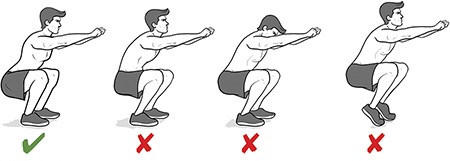How you squat (or not) can yield valuable clinical information
A properly executed squat uses a combination of several joints and muscles, including ankles, knees, hips, spine, abdominal muscles and tons of core strength! While a normal squat will follow normal functional movement, an abnormal squat may lead to additional stress and cause more strain to an already problematic area. Muscle weakness or tightness, instability and reduced joint motion can all be determined with this valuable diagnostic tool called the squat.
One reason the squat is a good evaluation tool is because it is a normal motion pattern – a part of the activities of daily living. We squat hundreds of times a day: getting in and out of the car, sitting in a chair, accessing items from the floor or shelves, exercising, and using the toilet. The inability to do these basic tasks is what may ultimately lead to infirmity and the need for assisted living.
There are several methods for evaluating the squat. For simplicity, it is good to start with the fundamental “air squat”. Prior to doing this though, ensure you can safely perform the squat by ruling out any joint injury with your chiropractor first.
How to do an air squat
- Stand with your heels shoulder-width apart and toes pointed forward or slightly out (not more than 10? of external rotation).
- Squat down until your thighs are at least parallel with the ground. You may extend your arms forward as a counter lever, but it is not required.
- Perform three repetitions while the chiropractor observes from the front; then three repetitions while observed from the side; and finally three more while observed from behind.

Characteristics of a normal, stable, solid squat
- Symmetry, i.e. you do not sway to one side.
- Your heels and toes remain on the ground; feet unmoved.
- Your knees do not travel forward beyond your toes.
- The lumbar curve is maintained throughout the squat.
- Your head and eyes remain up, neutral to slightly extended (never hyperextended!).
- Normal ankle dorsiflexion is maintained.
- Hip and knee motion should be fluid, pain free, and demonstrate good movement throughout the ranges required to perform the squat.
- Your knees should descend in alignment with the lower leg bones and not drift inward.

What does your squat say about you?
Poor head alignment and gaze: Possibly indicative of a spinal joint problem or loss of flexibility of the spine if you are unable to control your head appropriately during the squat. Spinal adjustments supported by strengthening and/or mobility exercises will assist this.
Thoracic spine and chest: The thorax should remain stiff and neutral throughout the squatting motion and is best evaluated from the side. The chest should be held upward. Forward curling of the thoracic spine may indicate a motor/muscle control issue or spinal joint fixation.
Lumbar spine: The lumbar spine should be held in a natural, curved position throughout the squat. The inability to achieve this may be due to weakness of muscles, or a spinal, hip or sacroiliac problem.
Hip position: Excessive abduction (outward movement) of the hips may indicate a femoral head problem, imbalance of the gluteal muscle complex, or reduced dorsiflexion of the ankles.
Knee motion: If a knee is twisted outward during the squat it is indicative of weakness of the gluteus maximus and/or other rotators of the hip. Knees should not drift inward either.
Foot motion: If the feet turn outward during the squat it is strongly associated with loss of normal ankle dorsiflexion. Both feet must remain planted firmly when squatting. Stretching and/or foot adjustments may be indicated.
Squat assessments are a valuable clinical tool for identifying biomechanical deficits and can help determine which sites would benefit from adjustments, exercise, neuromuscular or mobility training. Squats are particularly beneficial for analysing people who wish to participate in rigorous activities. The squat is a functional movement complex used in many activities of daily living as well as athletics.
